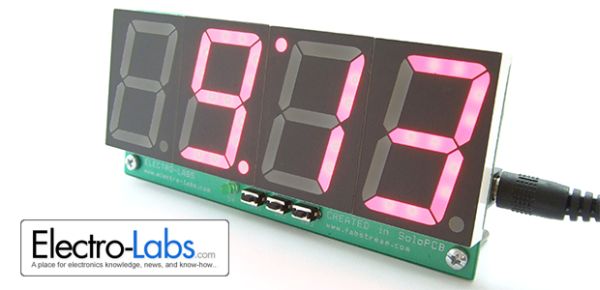One of the most enjoyable part of being an electronics person is creating your own gadgets and using them in daily life. In this article, we are building one of those with the help of SoloPCB design tools, a digital desk clock with temperature display feature.
The brain of the circuit is a Microchip PIC18F252 microcontroller. It acquires precise time information from DS1307 real time clock via I2C interface and displays it on four digit 38 mm seven-segment display with the help of MAX7219CNG display driver. The temperature data is read by the on-chip ADC module of the microcontroller from LM335 temperature sensor which outputs 10mV per kelvin degree linearly. The temperature data is also displayed periodically.
The PIC microcontroller and the peripheral ICs mentioned above needs 5V regulated supply to operate. The step-down converter in the power section of the circuit, LM2574N-5.0, converts 12VDC input voltage to 5VDC and lets to draw 500mA without any significant heating problem.
There are two LEDs on the board indicates power and functional status and the buttons let the user adjust the time and display the temperature manually.
The Circuit and the PCB Design
The circuit and the PCB of the project are drawn in SoloPCB. SoloPCB is a very powerful tool which integrates the circuit design to the PCB design and the fabrication. You can download SoloPCB from FabsSream for free. The circuit and the PCB files of the project are provided in SoloPCB format. You can download the design files including the symbol and the footprint libraries by using the download link below.
The following video demonstrates how to import the project libraries, open and synchronize the schematic and PCB files.
DIY Digital Desk Clock with Temperature Display
One of the most enjoyable part of being an electronics person is creating your own gadgets and using them in daily life. In this article, we are building one of those with the help of SoloPCB design tools, a digital desk clock with temperature display feature.
The brain of the circuit is a Microchip PIC18F252 microcontroller. It acquires precise time information from DS1307 real time clock via I2C interface and displays it on four digit 38 mm seven-segment display with the help of MAX7219CNG display driver. The temperature data is read by the on-chip ADC module of the microcontroller from LM335 temperature sensor which outputs 10mV per kelvin degree linearly. The temperature data is also displayed periodically.
The PIC microcontroller and the peripheral ICs mentioned above needs 5V regulated supply to operate. The step-down converter in the power section of the circuit, LM2574N-5.0, converts 12VDC input voltage to 5VDC and lets to draw 500mA without any significant heating problem.
There are two LEDs on the board indicates power and functional status and the buttons let the user adjust the time and display the temperature manually.
The Circuit and the PCB Design
The circuit and the PCB of the project are drawn in SoloPCB. SoloPCB is a very powerful tool which integrates the circuit design to the PCB design and the fabrication. You can download SoloPCB from FabsSream for free. The circuit and the PCB files of the project are provided in SoloPCB format. You can download the design files including the symbol and the footprint libraries by using the download link below.
The following video demonstrates how to import the project libraries, open and synchronize the schematic and PCB files.
There are also video tutorials available in the Videos category showing how to use the SoloPCB tools.
The circuit schematic of the digital desk clock and a screenshot from its PCB can be seen below.
For more detail: DIY Digital Desk Clock with Temperature Display – Part 1

